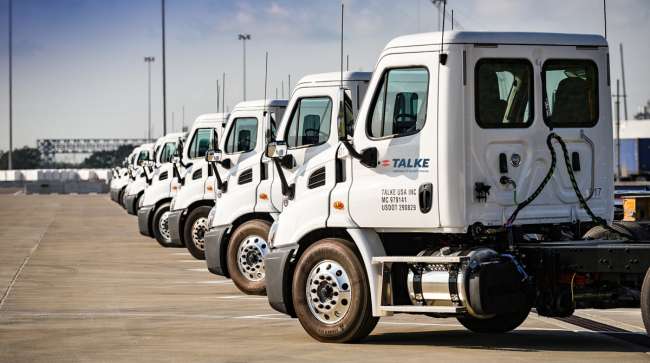
Hydrogen Fuel Cells Drive Talke USA’s Green Transition in Texas
October 17, 2025Back on October 10, 2025, Talke USA made a splash by announcing it would retrofit two of its trusty Class 8 drayage tractors in Mont Belvieu, Texas with hydrogen fuel cell powertrains. This isn’t just another green project—it’s a full-throttle leap into zero-emission technology right in the heart of America’s chemical corridor. In collaboration with Symbio North America, the pilot could scale up to 20 semi-trucks, showing off how hydrogen fuel cells can drive both industrial decarbonization and real-world logistics efficiency. For a region that handles more petrochemicals than almost anywhere else in the nation, that’s a game-changer. And yes, it slots perfectly into Talke’s ongoing Operation Clean Sweep Blue, keeping pellet spills at bay while curbing tailpipe pollution.
Upfitting Trucks: A Bold Pilot
Founded back in 1947, Talke USA has never shied away from fresh ideas. They’ve already harnessed digital consultancy and smart analytics to squeeze every drop of efficiency from their fleet. Now, they’re tackling carbon head-on. The plan: pick two of their workhorses—the Class 8 drayage tractors that shuttle containers between docks, terminals and storage yards—and gut the old diesel mills. In goes Symbio North America’s modular fuel cell pack, complete with tank-mounted hydrogen cylinders, a proton exchange membrane (PEM) fuel cell stack, a beefy electric traction motor and a compact lithium-ion buffer battery. Best part? Payload stays the same, range still hits diesel benchmarks, and a quick pit stop at a refueling station gets you back on the road in 10–15 minutes. It’s a bold bet—they’re essentially writing the playbook for retrofitting heavy-haulers to run on hydrogen infrastructure that’s just starting to emerge. If these rigs rack up thousands of drama-free miles, Talke’s looking to retrofit up to 20 trucks at its Mont Belvieu hub.
Technical Snapshot: Fuel Cell Technology Unpacked
At its core, a hydrogen fuel cells system is pure electrochemistry magic: hydrogen from the high-pressure tanks meets oxygen at the PEM, and voilà—electricity, heat and nothing but water vapor. No soot, no CO₂, just H₂O. Here’s the lineup under the hood:
- High-pressure storage: Robust tanks rated for 350–700 bar, holding enough H₂ for roughly 300–400 miles of driving.
- PEM fuel cell stack: A stack of membrane-electrode assemblies, each coated with catalysts to spark the reaction.
- Balance of plant: The unsung heroes—pumps, humidifiers, thermal controls and air compressors—that keep everything humming.
- Electric drivetrain: A 200–300 kW traction motor, paired with a lithium-ion buffer battery to absorb regen braking and smooth power delivery.
The result? Instant torque off the line, silky acceleration, and zero tailpipe emissions. Better yet, you get nearly double the system efficiency you’d see in a traditional diesel setup. And because it’s modular, swapping parts or boosting capacity down the road is as simple as plug-and-play.
Strategic Drivers: Policy, Economics and ESG
A few trends are converging to make this pilot irresistible right now. Millions of dollars from the Infrastructure Investment and Jobs Act are fueling six national hubs built around hydrogen infrastructure, with Texas leading the pack. Corporations—in particular chemical giants—are pushing for greener supply chains, so Talke’s move lines up perfectly with its ESG goals. By retrofitting existing tractors instead of buying brand-new rigs, they tap into grants, tax credits and state incentives, sidestep the sticker shock of a fleet overhaul and bolster their sustainability credentials with major clients. Add in anticipated cost declines for green hydrogen—analysts expect prices could dip below $2 per kilo by 2030—and suddenly the total cost of ownership for fuel cell trucks starts to give diesel a run for its money. Locking in fuel costs at predictable rates can also be a hedge against diesel’s roller-coaster pricing—a big win for CFOs and operations managers alike.
Mont Belvieu: A Strategic Epicenter
Roll the map east of Houston and you’ll hit Mont Belvieu, home to about 86,000 people and an intricate web of pipelines and storage terminals. It’s been a keystone in the US petrochemical chain for decades, making it an ideal spot to test drive a hydrogen refueling station. Talke’s local terminal plugs straight into that network, meaning both conventional and low-carbon fuels are never far away. The region even has budding partnerships for on-site electrolysis—perfect for a near-term green hydrogen supply that keeps emissions down and uptime up. With average rent per capita around $1,350, it’s a community ripe for new clean-tech jobs, from station operators to safety inspectors. And because local emergency services are already versed in handling hydrocarbons, adding hydrogen to the mix feels like a natural next step.
Overcoming Hurdles: From Refueling to Regulation
Let’s be real: swapping to hydrogen doesn’t come without its speed bumps:
- Patching the network: Public fill-up stations for H₂ are mostly pilot projects. Talke might need on-site electrolyzers or dedicated delivery trucks in the meantime.
- CapEx intensity: Fuel cell stacks, high-pressure tanks and specialized components carry a premium compared to diesel retrofits.
- Skills gap: Servicing hydrogen systems and working with high-pressure equipment demands extra training in safety and PEM tech.
- Regulatory maze: Navigating NFPA 2, DOT rules and local codes can be a complex puzzle.
Still, early adopters like Talke USA are the ones writing the rulebook. By logging real-world data, they help regulators, insurers and financiers understand the risks—and rewards—so future projects can move faster and cost less. They’re already teaming up with vocational schools to jumpstart training programs, and they’re in talks with regulators to streamline permitting. It’s a lot of legwork, but someone’s got to clear the path.
Looking Ahead: Scaling Zero-Emission Logistics
Sure, kicking off with two trucks might feel modest, but if Talke scales up to 20 drayage tractors, they could slice hundreds of tons of CO₂ emissions each year right in Mont Belvieu. Even better, this blueprint can be duplicated at ports up and down the coast and in industrial parks nationwide. As global supply chains tighten their belts on emissions, hydrogen fuel cells offer a sweet spot for heavy-duty loads where batteries still can’t match range or refuel speed. With Talke Group’s reach across Europe and Asia, insights from Texas could fuel deployments on three continents. The trick will be rallying tech partners, fuel suppliers and regulators to build out cost-effective hydrogen infrastructure. For shippers, the upside is clear: low-carbon trucks that sharpen your competitive edge and keep you on track for net-zero targets. Plus, transparent data on uptime, refueling cycles and maintenance expenses will give investors the confidence to back bigger rollouts. By shifting from lab to lot, Talke USA is showing that hydrogen hype can translate into horsepower—maybe even the tipping point for green hydrogen in heavy transport and the start of a whole new era in clean logistics.



 With over 15 years of reporting hydrogen news, we are your premier source for the latest updates and insights in hydrogen and renewable energy.
With over 15 years of reporting hydrogen news, we are your premier source for the latest updates and insights in hydrogen and renewable energy.